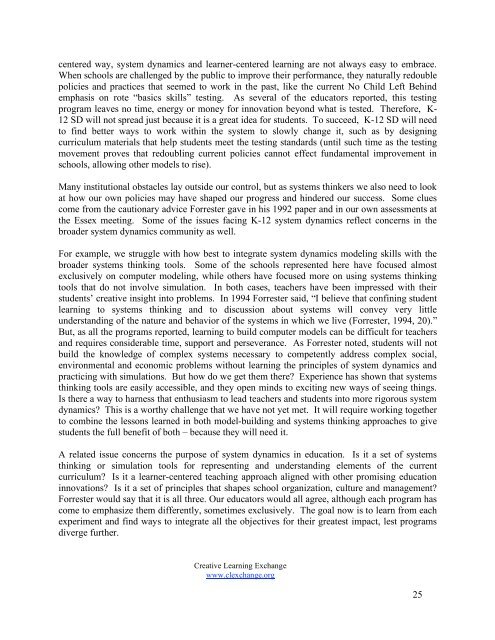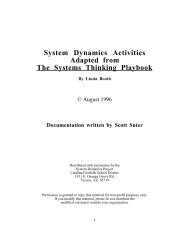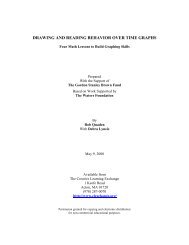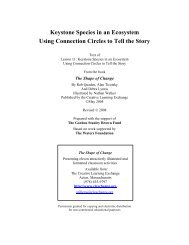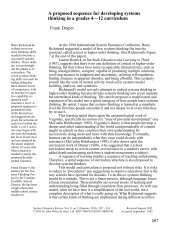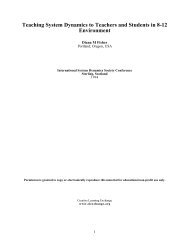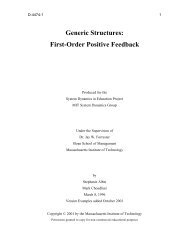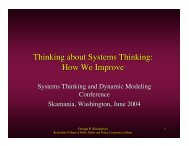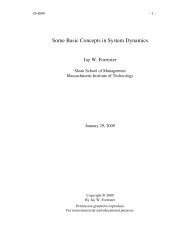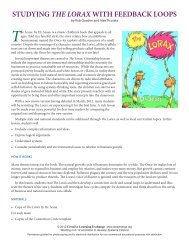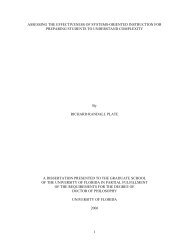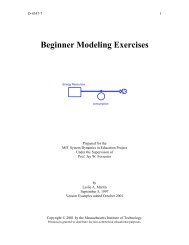System Dynamics in K-12 Education: Lessons Learned - Creative ...
System Dynamics in K-12 Education: Lessons Learned - Creative ...
System Dynamics in K-12 Education: Lessons Learned - Creative ...
Create successful ePaper yourself
Turn your PDF publications into a flip-book with our unique Google optimized e-Paper software.
centered way, system dynamics and learner-centered learn<strong>in</strong>g are not always easy to embrace.<br />
When schools are challenged by the public to improve their performance, they naturally redouble<br />
policies and practices that seemed to work <strong>in</strong> the past, like the current No Child Left Beh<strong>in</strong>d<br />
emphasis on rote “basics skills” test<strong>in</strong>g. As several of the educators reported, this test<strong>in</strong>g<br />
program leaves no time, energy or money for <strong>in</strong>novation beyond what is tested. Therefore, K-<br />
<strong>12</strong> SD will not spread just because it is a great idea for students. To succeed, K-<strong>12</strong> SD will need<br />
to f<strong>in</strong>d better ways to work with<strong>in</strong> the system to slowly change it, such as by design<strong>in</strong>g<br />
curriculum materials that help students meet the test<strong>in</strong>g standards (until such time as the test<strong>in</strong>g<br />
movement proves that redoubl<strong>in</strong>g current policies cannot effect fundamental improvement <strong>in</strong><br />
schools, allow<strong>in</strong>g other models to rise).<br />
Many <strong>in</strong>stitutional obstacles lay outside our control, but as systems th<strong>in</strong>kers we also need to look<br />
at how our own policies may have shaped our progress and h<strong>in</strong>dered our success. Some clues<br />
come from the cautionary advice Forrester gave <strong>in</strong> his 1992 paper and <strong>in</strong> our own assessments at<br />
the Essex meet<strong>in</strong>g. Some of the issues fac<strong>in</strong>g K-<strong>12</strong> system dynamics reflect concerns <strong>in</strong> the<br />
broader system dynamics community as well.<br />
For example, we struggle with how best to <strong>in</strong>tegrate system dynamics model<strong>in</strong>g skills with the<br />
broader systems th<strong>in</strong>k<strong>in</strong>g tools. Some of the schools represented here have focused almost<br />
exclusively on computer model<strong>in</strong>g, while others have focused more on us<strong>in</strong>g systems th<strong>in</strong>k<strong>in</strong>g<br />
tools that do not <strong>in</strong>volve simulation. In both cases, teachers have been impressed with their<br />
students’ creative <strong>in</strong>sight <strong>in</strong>to problems. In 1994 Forrester said, “I believe that conf<strong>in</strong><strong>in</strong>g student<br />
learn<strong>in</strong>g to systems th<strong>in</strong>k<strong>in</strong>g and to discussion about systems will convey very little<br />
understand<strong>in</strong>g of the nature and behavior of the systems <strong>in</strong> which we live (Forrester, 1994, 20).”<br />
But, as all the programs reported, learn<strong>in</strong>g to build computer models can be difficult for teachers<br />
and requires considerable time, support and perseverance. As Forrester noted, students will not<br />
build the knowledge of complex systems necessary to competently address complex social,<br />
environmental and economic problems without learn<strong>in</strong>g the pr<strong>in</strong>ciples of system dynamics and<br />
practic<strong>in</strong>g with simulations. But how do we get them there? Experience has shown that systems<br />
th<strong>in</strong>k<strong>in</strong>g tools are easily accessible, and they open m<strong>in</strong>ds to excit<strong>in</strong>g new ways of see<strong>in</strong>g th<strong>in</strong>gs.<br />
Is there a way to harness that enthusiasm to lead teachers and students <strong>in</strong>to more rigorous system<br />
dynamics? This is a worthy challenge that we have not yet met. It will require work<strong>in</strong>g together<br />
to comb<strong>in</strong>e the lessons learned <strong>in</strong> both model-build<strong>in</strong>g and systems th<strong>in</strong>k<strong>in</strong>g approaches to give<br />
students the full benefit of both – because they will need it.<br />
A related issue concerns the purpose of system dynamics <strong>in</strong> education. Is it a set of systems<br />
th<strong>in</strong>k<strong>in</strong>g or simulation tools for represent<strong>in</strong>g and understand<strong>in</strong>g elements of the current<br />
curriculum? Is it a learner-centered teach<strong>in</strong>g approach aligned with other promis<strong>in</strong>g education<br />
<strong>in</strong>novations? Is it a set of pr<strong>in</strong>ciples that shapes school organization, culture and management?<br />
Forrester would say that it is all three. Our educators would all agree, although each program has<br />
come to emphasize them differently, sometimes exclusively. The goal now is to learn from each<br />
experiment and f<strong>in</strong>d ways to <strong>in</strong>tegrate all the objectives for their greatest impact, lest programs<br />
diverge further.<br />
<strong>Creative</strong> Learn<strong>in</strong>g Exchange<br />
www.clexchange.org<br />
25


